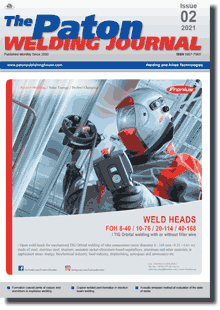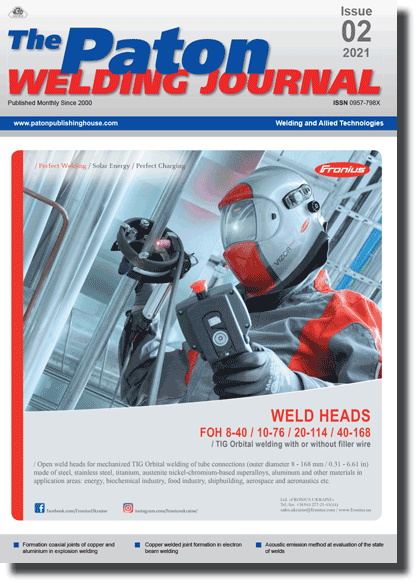| 2021 №02 (05) |
DOI of Article 10.37434/tpwj2021.02.06 |
2021 №02 (07) |

The Paton Welding Journal, 2021, #2, 33-36 pages
Influence of technological and metallurgical factors on copper welded joint formation in electron beam welding
V.M. Nesterenkov, L.A. Kravchuk and M.O. Rusynyk
E.O. Paton Electric Welding Institute of the NASU. 11 Kazymyr Malevych Str., 03150, Kyiv, Ukraine. E-mail: office@paton.kiev.ua
Abstract
The influence of technological and metallurgical factors on welded joint formation in electron beam welding of M1 copper grade with the thickness δ = 18 mm by a vertical electron beam in the flat position in a one pass was studied. The system of a computer control of the process of electron beam welding in the UL-209M installation allows performing cleaning of the adjacent butt zone from the remnants of contaminants and oxides using a low-power electron beam focused on the metal surface in a single technological cycle. The use of high-speed local electron beam scanning in a circle allowed a significant reduction in the temperature in the central part of the welding pool and, thus, eliminated burnouts and splash of weld metal. It was established that the optimal welding speed at an accelerating voltage Uacc = = 60 kV is in the range vw = 6–8 mm/s. Metallurgical treatment of welding pool with the help of inserts of aluminium and titanium foil eliminates the susceptibility to pores formation in the weld metal. 16 Ref., 1 Table, 5 Figures.
Keywords: electron beam welding, electron beam, computer control, circular scanning, penetration depth, input energy, welding speed, facial bead width, porosity
Received 30.11.2020
References
1. Kajdalov, A.A., Nazarenko, O.K. (1973) Some problems of theory of electron beam welding. Elektron. Obrab. Materialov, 3, 9-13 [in Russian].2. Shilov, G.A., Akopyants, K.S., Kasatkin, O.G. (1983) Influence of frequency and diameter of electron beam circular scan on metal penetration in EBW. Avtomatich. Svarka, 8, 25-28 [in Russian].
3. Ryzhkov, F.N., Bashkatov, A.V., Zakomoldin, A,F. et al. (1973) Welding of bronze Br.Kh0.8 and steel EI811 with oscillating electron beam. Ibid., 5, 56-58 [in Russian].
4. Johnson, L.D. (1970) Some observation on the electron-beam welding of copper. Weld. J., 49, 2, 55-60.
5. Anoshin, V.A., Ilyushenko, V.M., Bondarenko, A.N. et al. (2014) Integrated evaluation of effect of main impurities on weldability of copper. The Paton Welding J., 11, 24-27. https://doi.org/10.15407/tpwj2014.11.04
6. Paton, B.E., Nazarenko, O.K., Nesterenkov, V.M. et al. (2004) Computer control of electron beam welding with multi-coordinate displacements of the gun and workpiece. Ibid., 5, 2-5.
7. Nesterenkov, V.M., Kravchuk, L.A., Arkhangelsky, Yu.A. et al. (2015) Electron beam welding of medium-pressure chamber of gas turbine engine. Ibid., 12, 29-33. https://doi.org/10.15407/tpwj2015.12.06
8. Nazarenko, O.K., Kajdalov, A.A., Kovbasenko, S.N. et al. (1987) Electron beam welding. Kiev, Naukova Dumka [in Russian].
9. Skryabinskyi, V.V., Nesterenkov, V.M., Rusynyk, M.O. (2020) Electron beam welding with programming of beam power density distribution. The Paton Welding J., 1, 49-53. https://doi.org/10.37434/as2020.01.07
10. Nesterenkov, V.M. (2003) Special features of capillary waves in the vapour-gas channel in electron beam welding of thick metal. Ibid., 4, 7-12.
11. Agarkov, V.Ya. (1980) Electron beam welding of copper (Review). Avtomatich. Svarka, 11, 42-43 [in Russian].
12. Nazarenko, O.K., Agarkov, V.Ya., Ikonnikov, V.I. (1986) Influence of method of edge preparation on weld pore formation in electron beam welding. Ibid., 2, 21-25 [in Russian].
13. Goncharov, A.N., Krivosheya, V.E. (1980) Effect of alloy additives on weldability of copper. In: Current problems of welding of nonferrous metals. Kiev, Naukova Dumka, 221- 225 [in Russian].
14. Ilyushenko, V.M., Anoshin, V.A., Bondarenko, A.N. et al. (1980) Investigation of influence of additives and a number of alloying elements on crack formation in welding of copper. Ibid., 217-221 [in Russian].
15. Kolachev, Ya.L., Livanov, V.A., Elagin, V.I. (1981) Metals science and heat treatment of nonferrous metals and alloys. Moscow, Metallurgiya [in Russian].
16. Si, L., Zhou, L., Zhu, X. et al. (2016) Microstructure and property of Cu-2,7Ti-0,15Mg-0,1Ce-0,1Zr alloy treated with a combined aging process. Mater. Sci. Eng.: A650, 345-353. https://doi.org/10.1016/j.msea.2015.10.062
Suggested Citation
V.M. Nesterenkov, L.A. Kravchuk and M.O. Rusynyk (2021) Influence of technological and metallurgical factors on copper welded joint formation in electron beam welding. The Paton Welding J., 02, 33-36.The cost of subscription/purchase order journals or individual articles
| Journal/Currency | Annual Set | 1 issue printed |
1 issue |
one article |
| TPWJ/USD | 384 $ | 32 $ | 26 $ | 13 $ |
| TPWJ/EUR | 348 € | 29 € | 24 € | 12 € |
| TPWJ/UAH | 7200 UAH | 600 UAH | 600 UAH | 280 UAH |
| AS/UAH | 1800 UAH | 300 UAH | 300 UAH | 150 UAH |
| AS/USD | 192 $ | 32 $ | 26 $ | 13 $ |
| AS/EUR | 180 € | 30 € | 25 € | 12 € |
| SEM/UAH | 1200 UAH | 300 UAH | 300 UAH | 150 UAH |
| SEM/USD | 128 $ | 32 $ | 26 $ | 13 $ |
| SEM/EUR | 120 € | 30 € | 25 € | 12 € |
| TDNK/UAH | 1200 UAH | 300 UAH | 300 UAH | 150 UAH |
| TDNK/USD | 128 $ | 32 $ | 26 $ | 13 $ |
| TDNK/EUR | 120 € | 30 € | 25 € | 15 € |
AS = «Automatic Welding» - 6 issues per year;
TPWJ = «PATON WELDING JOURNAL» - 12 issues per year;
SEM = «Electrometallurgy Today» - 4 issues per year;
TDNK = «Technical Diagnostics and Non-Destructive Testing» - 4 issues per year.


